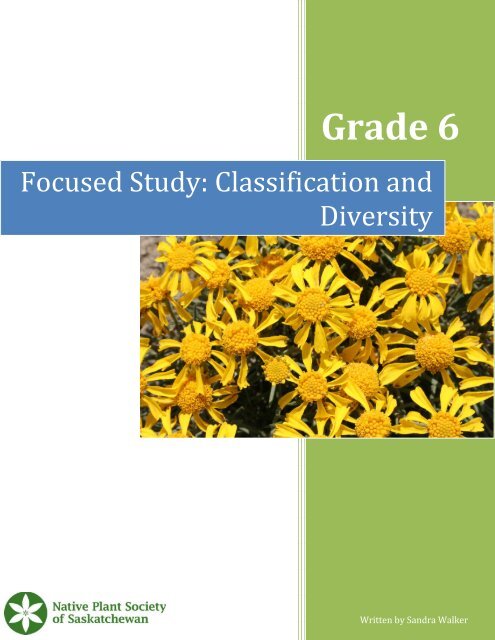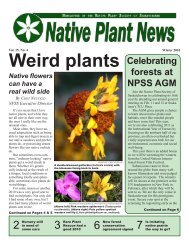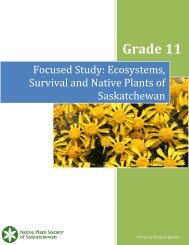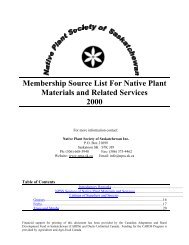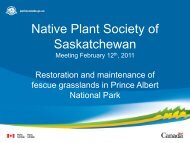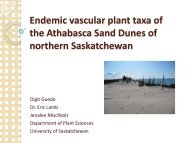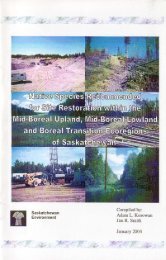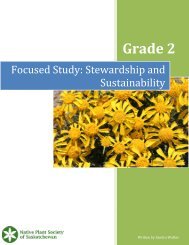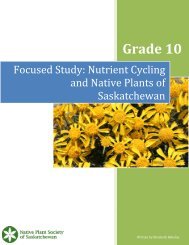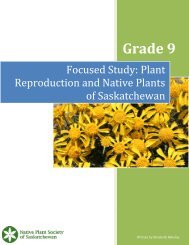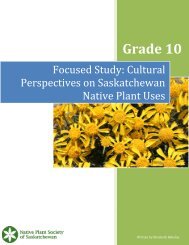Grade 6 Lesson Plan - Native Plant Society of Saskatchewan
Grade 6 Lesson Plan - Native Plant Society of Saskatchewan
Grade 6 Lesson Plan - Native Plant Society of Saskatchewan
- No tags were found...
You also want an ePaper? Increase the reach of your titles
YUMPU automatically turns print PDFs into web optimized ePapers that Google loves.
<strong>Grade</strong> 6Focused Study: Classification andDiversityWritten by Sandra Walker
The <strong>Native</strong> <strong>Plan</strong>t <strong>Society</strong> <strong>of</strong> <strong>Saskatchewan</strong> is a strong advocate <strong>of</strong> natureeducation.In addition to this lesson plan, we also support schools by:- providing free printed resources.- leading field tours.- delivering outdoor and classroom presentations.- hosting opportunities to "ask an expert", where students can interact with apr<strong>of</strong>essional biologist or related occupation though in person events or Skype. In somecases, we can arrange for French speaking experts.We also support the establishment <strong>of</strong> native plant learning gardens on school groundsby <strong>of</strong>fering free native seeds, printed resources, personal visits, presentations andexpert advice to help with all stages <strong>of</strong> the process. The gardens can be as small as asquare meter.All <strong>of</strong> what we do is always free for participating schools.Does any <strong>of</strong> this sound like something you'd want? If so, please call us at (306) 668-3940 or e-mail us at info@npss.sk.caFree Electronic Resources on the <strong>Native</strong> <strong>Plan</strong>t <strong>Society</strong> <strong>of</strong> <strong>Saskatchewan</strong> Website(www.npss.sk.ca)A Guide to Small Prairie Restoration - How to Grow Your Own Patch <strong>of</strong> <strong>Native</strong> Prairie<strong>Saskatchewan</strong>'s <strong>Native</strong> Prairie: Taking Stock <strong>of</strong> a Vanishing Ecosystem and DwindlingResource (Also available in print)On the Prairie - A webpage on our site with a "Build a Prairie" game, field guide toprairie plants and animals, curriculum goodies like a English-Dakota language guide, andvirtual reality panoramas <strong>of</strong> prairie placesThe Watershed GameFree Printed Materials Available Through the <strong>Native</strong> <strong>Plan</strong>t <strong>Society</strong> <strong>of</strong> <strong>Saskatchewan</strong>:<strong>Native</strong> <strong>Plan</strong>ts, Water and Us! (Booklet)<strong>Native</strong> <strong>Plan</strong>ts, Water and Us! (Poster)<strong>Native</strong> <strong>Plan</strong>t Communities <strong>of</strong> <strong>Saskatchewan</strong> (Poster)<strong>Native</strong> <strong>Plan</strong>t Communities <strong>of</strong> <strong>Saskatchewan</strong> (Activity Sheet)
FOCUSED STUDY: CLASSIFICATION AND DIVERSITYGRADE 6OVERVIEW AND PURPOSEThe guided study <strong>of</strong> living things in <strong>Grade</strong> 6 can incorporate simple uses <strong>of</strong> classification as a way<strong>of</strong> learning about the great diversity <strong>of</strong> species and as ways <strong>of</strong> organizing the study <strong>of</strong> species.Classifying will enable students to learn about many different species in different environmentswhich will help them to observe and describe similarities and differences among species moreprecisely.At the end <strong>of</strong> the study, students should be able to roughly classify species into basic categories,understand the importance <strong>of</strong> species diversity, and appreciate the need to conserve andprotect species. Students should be able to describe in basic terms how a few species are ableto adapt and survive in different environments. Students will also have an appreciation <strong>of</strong>possible related careers in areas such as biology and environmental science.OUTCOMES AND INDICATORSDL6.1 Recognize, describe, and appreciate the diversity <strong>of</strong> living things in local and otherecosystems, and explore related careers. [CP, SI]Examine how humans organize understanding <strong>of</strong> the diversity <strong>of</strong> living things. [CP, SI]Examine and describe structures and behaviours that help:Individual living organisms survive in their environments in the short term.Species <strong>of</strong> living organisms adapt to their environments in the long term.State the characteristics that define all living things (e.g., are made up <strong>of</strong> one ormore cells, require energy for life processes, respond to stimuli in theirenvironment, and have the ability to reproduce).DL6.1 Recognize, describe, and appreciate the diversity <strong>of</strong> living things in local and otherecosystems, and explore related careers. [CP]Identify examples <strong>of</strong> science and technology-related careers and workplaces which require anunderstanding <strong>of</strong> the diversity <strong>of</strong> living things (e.g., naturalist, zoo keeper, palaeontologist, andwildlife biologist).Observe and document the diversity <strong>of</strong> living things in their local habitat through journaling, anature walk, sketching, drawing, photographing, video recording, or other means.Show respect for other people, living things, and the environment when observing ecosystems.Document the diversity <strong>of</strong> living things in different terrestrial and aquatic habitats (e.g.,grasslands, forests, tundra, deserts, rivers, ponds, and oceans) using print, video, and/or onlineresources.
Analyze how First Nations and Métis art and storytelling highlight movement and/or behaviour<strong>of</strong> living things and reflect a worldview that values all living things.MATERIALS<strong>Plan</strong>t identification books/keys, including basic books on plant and animal identification, theinternet (if available), paper and pencils for drawing. Cameras are essential if you would like torecall plant or animal features for future identification. Print media, internet resources or a talkwith a First Nations Knowledge Keeper and/or ethnobotanist would be an asset with respect toFirst Nations perspectives.INTRODUCTION, BACKGROUND AND SUGGESTED METHODSIn classifying things in nature, there are a few very general rules to follow when trying to decideif something is living, dead, or non-living. Listed here are the six rules <strong>of</strong>ten used by scientists:Living things are made <strong>of</strong> cells.Living things obtain and use energy.Living things grow and develop.Living things reproduce.Living things respond to their environment.Living things adapt to their environment.The environment influences the living things that it surrounds. Living things can alter theirenvironment, but nonliving things cannot. Living things, for example, may migrate or hibernate(adapt) if the environment becomes difficult to live in. These are shorter term examples <strong>of</strong>adaptation.Populations <strong>of</strong> living organisms also have the ability to adapt to their environment through theprocess <strong>of</strong> evolution, which is a longer term type <strong>of</strong> adaptation. During evolution, changes occurin populations, and the organisms in the population become better able to metabolize, respond,and reproduce. They develop abilities to cope with their environment that their ancestors didnot have.All organisms undergo the process <strong>of</strong> adaptation to suit themselves to their environment. Forexample, some plants that are found in dry areas have succulent leaves that allow them to storeand conserve water, small and/or ridged leaves or leaves covered in hair or wax to slow waterloss, or extensive fibrous roots to efficiently capture moisture. These kinds <strong>of</strong> plants are <strong>of</strong>tencalled dryland plants and are frequently found in drier soils or drier areas.<strong>Plan</strong>ts and animals have adapted to their environments genetically and by means <strong>of</strong>physiological, behavioural, or developmental flexibility, including both instinctive behaviour andlearning. Adaptation has many dimensions in that most organisms must conformsimultaneously to numerous different aspects <strong>of</strong> their environments. Adaptation involvescoping not only with the physical abiotic environment (light, dark, temperature, water, wind),but also with the complex biotic environment (other organisms such as mates, competitors,parasites and predators). Conflicting demands <strong>of</strong> these various environmental components<strong>of</strong>ten require that an organism compromise in its adaptations to each. In other words,organisms <strong>of</strong>ten cannot adapt perfectly to all challenges in their environment, but do so as bestthey can.
Organisms can conform to and cope with a highly predictable environment relatively easily,even when it changes in a regular way, as long as the changes are not too extreme. Adaptationto an unpredictable environment is usually more difficult; adapting to extremely erraticenvironments may even prove impossible. Many organisms have evolved dormant stages thatallow them to survive unfavorable periods, both predictable and unpredictable. Examples hereinclude the production <strong>of</strong> seed that can stay dormant for years or plant dormancy during winter,which is predictable here in <strong>Saskatchewan</strong>. Dormancy is also useful for plant survival during lesspredictable periods, such as in the case <strong>of</strong> drought.Very small undirected changes in the physical environment can sometimes improve the level <strong>of</strong>adaptation between an organism and its environment, but large changes are almost alwaysdetrimental. Changes in the environment that reduce overall adaptation are collectively termedthe "deterioration <strong>of</strong> environment." Such changes cause directional selection resulting inaccommodation to the new environment, or adaptation.Every individual is simultaneously a member <strong>of</strong> a population, a species, and a community;therefore, it must be adapted to cope with each and must be considered in that context. Anygenetically based physiological, behavioural, or ecological trait that enables an organism to copewith, and to survive and reproduce in, its environment represents an adaptation.There are diverse and numerous living organisms in different habitats around the world.Using classification systems, we can learn to recognize the similarities and differences amongliving organisms. There are numerous ways in which to classify living things, depending on one’sneeds. Common classification systems help to develop and communicate commonunderstandings and use basic terminology. Current biological classification systems are basedon both internal and external characteristics and behaviours and are quite scientific.One <strong>of</strong> the ways scientists quantify Earth's terrestrial biodiversity is by classifying vegetation intolarge, regional ecological units by dominant vegetative patterns, better known as biomes. Thesebiomes include the tropical forest, savanna, desert, chaparral, grassland, temperate forest, taigaor boreal forest and tundra. Each biome is distinctive due to the amount <strong>of</strong> annualprecipitation, number <strong>of</strong> frost-free days and other physical and biological factors.Scientific terminology breaks down classification further, such as if a component is abiotic (notbiological) or biotic (biological), whether the life form is a micro-organism, if it is a fungus,whether it has a backbone or not (vertebrates and invertebrates), what kingdom does the lifeform belong to (animal or plant), and whether the ecosystem is terrestrial (land based) oraquatic (water based) in addition to other characteristics including behaviour and reproduction.ACTIVITYIt is recommended that students first be introduced to the diversity <strong>of</strong> living things near theschool and in their neighbourhood, and could focus on providing a short list <strong>of</strong> species. Studentscould break up into groups and be provided with reference books (i.e., one group with a birdbook, one with a plant book, one with an insect book), and have them work in small groups t<strong>of</strong>ind two or more species to add to the list. This activity could be combined with journaling, awalk, sketching, drawing, photographing, video recording or through other means. Studentswould be encouraged to share their results with the class, in addition to naming one thing abouteach plant, animal or insect that has helped it adapt to its habitat.
Once a few <strong>of</strong> the local habitats have been explored, students could investigate the diversity <strong>of</strong>living things in different terrestrial and aquatic habitats on the surrounding prairies, such asgrasslands, parklands or wetlands, using print, video and/or online resources. Again, groupscould break up into groups and choose a few species to investigate in a specific habitat.Students would be encouraged to share their results with the class, in addition to describing onething about each plant, animal or insect that has helped it adapt to its habitat. Can all <strong>of</strong> thespecies chosen live in the same habitat? Why or why not?Prairie grasslands and grasses provide a good example <strong>of</strong> diversity and adaptation on thesurrounding prairies. Within this ecosystem are many grasses, including species like needle andthread grass, blue grama grass, june grass and western wheatgrass, that have adapted to theextreme climate conditions <strong>of</strong> the prairies. Not only can these plants hibernate over coldwinters, but can tolerate significant loss <strong>of</strong> plant material, and in fact respond well todisturbances such as fire and moderate grazing. Livestock and wildlife, in turn, depend onhealthy, renewed grasslands for nutrition and shelter. The ability <strong>of</strong> native grasses to thrive inthe face <strong>of</strong> fire and grazing is a result <strong>of</strong> their defensive design and adaptations. These types <strong>of</strong>plants grow mostly from their base, with some elongation <strong>of</strong> the stem. Some <strong>of</strong> the leaves evenstart out below the ground to protect the shoot from above ground disturbances. Also, much <strong>of</strong>the biomass <strong>of</strong> native grasses is composed <strong>of</strong> root material, which is protected against fire andgrazing and helps the plant to recover. This unique adaptation protects critical parts formaintaining future growth from disturbances that destroy or seriously damage other plants.Because prairie grasses are adapted to fire, fire is <strong>of</strong>ten used as a management tool to maintaintheir health and productivity. Burning grasses enhances grassland vigor by increasing speciesdiversity, reducing noxious weeds, cycling nutrients back into the soil and eliminating excessivewoody vegetation. Species diversity is enhanced as grasses are given room to grow whenundesirable invading species are removed. Woody plants and noxious weeds are commoninvaders <strong>of</strong> prairie wetlands and grasslands deprived <strong>of</strong> fire. Since woody plants grow from theirtips, unlike grasses which grow from their protected base, woody plants are much moredamaged by fire and are slower to recover, giving prairie grasses an advantage.What other adaptations have grasses developed to survive on the prairies? Examples includespecialized seed dispersal mechanisms, cool or warm season growth patterns, or specialized leafstructures that conserve moisture (such as waxy, rolled, ridged or hairy leaves).BIODIVERSITY AND ENVIRONMENTAL IMPACTBiodiversity is defined as the variability among living organisms from all sources includingterrestrial, marine and other aquatic systems and the ecological complexes <strong>of</strong> which they are apart; this includes diversity within species, between species and <strong>of</strong> ecosystems. Biodiversitymay, therefore, be seen as an indicator <strong>of</strong> environmental health.Diversity <strong>of</strong> living things and the diversity <strong>of</strong> human cultures together make up the diversity <strong>of</strong>life on the planet. There is an immense variety <strong>of</strong> living (and even non-living) things on thisplanet, forming a complex web <strong>of</strong> communities and ecosystems. They have grown and changedthrough billions <strong>of</strong> years <strong>of</strong> evolution. Humans are a part <strong>of</strong> this web, and are dependent onother living things for the air we breathe, the food we eat, the resources we use and theenvironment we live in. Within the human species there is an incredible amount <strong>of</strong> diversity;
there are many different languages, cultures, beliefs, and ideas. The interaction betweenbiological and cultural diversity contributes to the health <strong>of</strong> our planet. This cultural diversity,through culture-based conservation, maintenance <strong>of</strong> traditional knowledge, revitalization <strong>of</strong>local practices <strong>of</strong> natural resource use and conserving species and ecosystems, is an importantasset in maintaining our environment.These assets <strong>of</strong> cultural diversity could be <strong>of</strong> use in sustaining our prairie landscape, which hasbeen substantially altered over the past century. In many places, cultivated annual crops havereplaced the grasses which previously covered the land. In fact, modern agriculture can be saidto have had a greater impact on biodiversity in the Great Plains region than any other activity.As agriculture became more intensive, wetlands were drained, trees were removed and moregrassland was cultivated. These actions, while being advantageous for the use <strong>of</strong> large modernequipment and the production <strong>of</strong> massive amounts <strong>of</strong> food, effectively destroyed the habitat formany plant and animal species. In no area was this development scheme more effectivelyapplied than on the open prairie. More than 80 percent <strong>of</strong> the prairie landscape has beenaltered, mostly by agriculture. Drainage for use by agriculture has been responsible for 85percent <strong>of</strong> the total land drained. Continued expansion <strong>of</strong> the area for agriculture, whether byremoval <strong>of</strong> native prairie trees or extension into the parkland area, serves to reduce the habitatfor wildlife. Animals also suffer from the reduction in habitat, <strong>of</strong>ten being forced to retreat intomore remote areas. In many parts <strong>of</strong> the prairies native vegetation has become a thing <strong>of</strong> thepast. On the prairies, 60 percent <strong>of</strong> the wetland basins and 80 percent <strong>of</strong> the habitatsurrounding these basins are affected by farming each year. This occurrence has a significantimpact on waterfowl. Overgrazing by cattle and other domestic animals reduces plant cover andthe supply <strong>of</strong> food and shelter for meadow and grassland species <strong>of</strong> mammals, birds andinvertebrates. On the other hand, some forms <strong>of</strong> wildlife thrive under the conditions arisingfrom agriculture. Farm shelterbelts provide cover for numerous species <strong>of</strong> birds, includingsharp-tailed grouse and the rare loggerhead shrike. Other species have benefited from theincreased feeding opportunities provided by agricultural crops. These include ducks, geese,sandhill cranes, robins, blackbirds, deer and moose.Environmental impacts from human activities are not limited to the central and southern parts<strong>of</strong> <strong>Saskatchewan</strong>. The northern parts <strong>of</strong> <strong>Saskatchewan</strong> have large forests, and are divided intothe northern and southern boreal forests. The northern boreal forest is made up mostly <strong>of</strong>coniferous species, which are cone bearing seed plants. Poor soil conditions coupled with thecolder climate limits the growth and size <strong>of</strong> trees and the diversity <strong>of</strong> plants.The southern boreal forest has richer soils and longer growing seasons and as a result has morekinds <strong>of</strong> plants and is more productive. This is shown by the large areas <strong>of</strong> very tall trees whichcan reach heights <strong>of</strong> 25 to 30 m. It is in the more productive southern boreal forest that mosttimber harvesting occurs in <strong>Saskatchewan</strong>. Large areas <strong>of</strong> this forest have been rented t<strong>of</strong>orestry firms that harvest the trees. As the timber harvesting expands, timber harvesting isstarting to replace fire as the main disturbance <strong>of</strong> these areas. Both fires and harvesting leavebehind even-aged stands <strong>of</strong> forest. However, fires leave behind the tree bodies, both standingand laying down, which provide habitat for wildlife. These burned tree bodies also decomposeand help feed wood boring insects which in turn feed birds. Decomposing trees also feed fungiand, ultimately, the soil. Richer soils mean healthier plants. Harvesting removes many <strong>of</strong> thetree bodies and the area is mostly left bare. Natural fires also help conifers such as jack pine,germinate, as the heat from the fires opens the waxy cones and allows the seeds to spread.
Harvested areas tend to have less conifers regrowing, and conifer trees are <strong>of</strong>ten planted tohelp regenerate the forest.Tree harvesting impacts to wildlife are worth exploring. Harvesting large areas <strong>of</strong> forest createsopen habitat, making it difficult for animals such as woodland caribou to evade predators,including bears, wolves and humans. Tree and ground nesting birds are also impacted, as theyno longer have the seeds and insects associated with the trees, or the protective foreststructure to build their nests. They must either build their nests in more open areas, or moveelsewhere. For the endangered woodland caribou, a main source <strong>of</strong> food is reduced. When theforest structure is removed during harvesting, the slow growing lichens that grow on the groundand on the older trees are impacted. Ground and rock lichens that may take hundreds <strong>of</strong> yearsto grow in sheltered, older forests are exposed to the elements <strong>of</strong> sunlight and wind. Largepockets <strong>of</strong> lichens growing on the forest floor are baked in the sun. Tree or arboreal lichens,which grow on older trees, are removed and no longer available for a considerable period <strong>of</strong>time. These lichens are important sources <strong>of</strong> food for the woodland caribou, who must move toother areas where they can find lichens. Lichens are also indicators <strong>of</strong> a healthy environment. Ifyou look at the trees in a city, even in old neighbourhoods, you probably will not see manylichens, because they will not grow in an air polluted area.Alternative methods <strong>of</strong> harvesting do exist that have less impact on the environment andwildlife, such as labour intensive selection logging. This approach, where only selected maturetrees are removed from a forest, <strong>of</strong>ten done in winter using horse drawn skidding methods,retains forest cover and reduces environmental impacts. A good example <strong>of</strong> the success <strong>of</strong> thisapproach has been demonstrated on Vancouver Island by Merv Wilkinson. Harvesting this 55hectare forest began in 1935, and had 1.5 million board feet <strong>of</strong> standing timber. Since this time,the land has been logged nine times, and has removed approximately 1.25 million board feet <strong>of</strong>timber. Today, this forest has a diverse, intact forest ecosystem with nearly the same volume <strong>of</strong>standing timber it had in 1935 (Hammond, 1991: 197). These kinds <strong>of</strong> harvesting methodsshould be encouraged to be used more <strong>of</strong>ten. At present, because it is more economical(cheaper), large machines and clear-cut methods are usually used to harvest trees in<strong>Saskatchewan</strong>.Biological resources are largely renewable and output can be increased under appropriatemanagement. Natural habitats which can maintain productivity without significantmanagement have the ability to provide means for human survival. Highly diverse naturalecosystems also provide important ecological services. These include maintaining hydrologicalcycles, regulating climate, contributing to the process <strong>of</strong> soil formation and maturation, storingand cycling essential nutrients, absorbing and breaking down pollutants and providing sites forinspiration, tourism, recreation and research. While nature has some built-in redundancy, littledata are available on which species are particularly important in the functioning <strong>of</strong> ecosystemsso that the actual value <strong>of</strong> specific losses <strong>of</strong> biodiversity is not available. There is need, however,to at least maintain biodiversity by maximizing the number <strong>of</strong> different species conserved insufficient quantities to assure survival.ACTIVITYStudents should be encouraged to consider what they can do to support diversity. Examplesaround us include reducing ecological footprints by examining how behaviours impact theenvironment. Simple activities can include “reduce, reuse and recycle.” Create a wildlife habitat
in your yard or schoolyard by planting native plants. The <strong>Native</strong> <strong>Plan</strong>t <strong>Society</strong> <strong>of</strong> <strong>Saskatchewan</strong>(NPSS) has a guide for planting native plants in schoolyards entitled “A Guide to Small ScalePrairie Restoration: How to Grow Your Own Patch <strong>of</strong> <strong>Native</strong> Prairie.” The NPSS also has a nativeplant material supplier list.Ecological footprints can be easily accomplished by decreasing greenhouse gas emissions – walkor ride a bike to get around when you can. Reduce your pesticide use and minimize theintroduction <strong>of</strong> these and other chemicals into the environment and waterways. Look intoorganic gardening and xeriscaping to conserve water. Eat organic foods. Buy directly from localproducers - this reduces the amount <strong>of</strong> transport needed to get food to market. Eat grass-fedbeef and bison, which are more likely raised in natural environments. Grow a garden. Spendtime in nature. Take an eco-tour in your area. Learn more about the wildlife, ecosystems andendangered spaces near you. Walk the land. Uncover old stories about the area you live in orfrom your ancestors, or create new stories. Spend time with the Elders <strong>of</strong> your community.ENVIRONMENTAL CAREERSStudents should be encouraged to explore careers which require an understanding <strong>of</strong> livingthings. Careers in this area are numerous and are in high demand, especially in provinces suchas <strong>Saskatchewan</strong> which are undergoing substantial economic growth in a number <strong>of</strong> areas whichrequire environmental specialists. Some examples <strong>of</strong> these careers are as follows:Agriculture EngineeringAgronomistAnimal ScientistAquaristAquatic ScientistArchaeologistBiologistBiomedical EngineerBotanistConservation ScientistConservation OfficerEcologistEnvironmental Compliance InspectorEnvironmental ConsultantEnvironmental EngineerEnvironmental Health ScientistEnvironmental TechnicianEthnobotanistForesterGame WardenGeologist, Geochemist and GeophysicistGreen Energy Careers GuideHorticulturistHydrographerLand Management CareersLimnologistMarine Biology and Oceanography CareersMeteorology CareersMicrobiologistNational Park Service CareerNatural Resource ManagerNatural Science ManagerOceanographerOutdoor Adventure GuideOutdoor Career GuidePark NaturalistPalaeontologistRange ManagerRecreation WorkerSoil ScientistSurveyor or CartographerUnderwater ExplorationUrban and Rural Land Use <strong>Plan</strong>nersWaste Management CareersWater Industry CareersWildlife BiologistWildlife OfficerZookeeperZoological ServicesZoologist
Each student could be encouraged to choose one career in the life sciences and research whatthe job involves on a day to day basis. Students could present their results to the class, includingtheir thoughts on whether they would like to pursue that career. The <strong>Native</strong> <strong>Plan</strong>t <strong>Society</strong> <strong>of</strong><strong>Saskatchewan</strong> can help arrange for a biologist to talk with the class about careers.FIRST NATIONS WORLDVIEWSStudents are encouraged to research First Nations and Métis art and/or storytelling andinvestigate how they highlight behaviour and value <strong>of</strong> all living things. Print media, internetsources and perhaps a talk with an Elder, using appropriate protocols, could be employed.Students could take notes and make a brief presentation <strong>of</strong> how a work <strong>of</strong> art, story, legend orinformation from a Knowledge Keeper helps reflect a worldview that values all living things.Indigenous people have had and continue to have an intimate relationship with, and knowledge<strong>of</strong>, the land. These people viewed the ecosystems in which they lived with caution and respect;this did not mean that they left their landscapes untouched or in a “natural” state. On thecontrary, they were active landscape architects, and they used fire extensively to modify plantcommunities and the distribution <strong>of</strong> animals, but only after careful consideration.Models <strong>of</strong> the local ecosystem and the skills necessary for making a livelihood from it werepassed from Elders to younger generations by example with the help <strong>of</strong> ceremonies and stories.People living directly from their landscape by hunting, fishing, gathering, and gardening spentmost <strong>of</strong> their time encountering, observing, and interacting with non- human animals andplants, and developed a deep understanding <strong>of</strong> nature.At the end <strong>of</strong> the study, students should be able to roughly classify species into basic categories,understand the importance <strong>of</strong> species diversity, and appreciate the need to conserve andprotect species. Students should be able to describe in basic terms how a few species are ableto adapt and survive. Students will also have an appreciation <strong>of</strong> possible related careers in areassuch as biology and environmental science.ASSESSMENT1. Name one plant that lives in your community and one way in which it has adapted to itsenvironment.2. Name one native plant that lives in a local ecosystem and one way in which it has adapted toits environment.3. Name two ways in which life forms can be classified.4. Describe at least two ways that people can help preserve the environment.5. Name at least one career in the life sciences that requires an understanding <strong>of</strong> the diversity <strong>of</strong>living things.INQUIRYExplore, observe, listen, record, investigate, acknowledge sources, interpret, plan, and create.Questions:What can we learn about sustainability from First Nations?Are native plants still an important part <strong>of</strong> the diversity <strong>of</strong> living things and why?How can we reduce our carbon footprint?
RESOURCESBooks:Aikenhead, G. and H. Michell. 2011. Bridging Cultures: Indigenous and Scientific Ways <strong>of</strong>Knowing Nature. Pearson Canada. Toronto.Grant, T. and Littlejohn, G. 2010. Greening School Grounds: Creating Habitats for Learning.New <strong>Society</strong> Publishers. Gabriola Island.Savage, C. 2011. Prairie: A Natural History. Greystone Books. Vancouver.Websites:Center for Ecoliteracyhttp://www.ecoliteracy.org/essays/systems-thinking<strong>Native</strong> <strong>Plan</strong>t <strong>Society</strong> <strong>of</strong> <strong>Saskatchewan</strong> - On the Prairie (Online games, curriculum goodies andmore!)http://www.npss.sk.ca/games/<strong>Native</strong> <strong>Plan</strong>t <strong>Society</strong> <strong>of</strong> <strong>Saskatchewan</strong> - Watershed Gameshttp://www.npss.sk.ca/watershed/<strong>Saskatchewan</strong>'s Ecoregions and Major Areas <strong>of</strong> Biodiversityhttp://econet.ca/issues/biodiversity/ecoregions.htmlIntegrating First Nations and Métis Content and Perspectivehttp://www.spiritsd.ca/learningresources/FNM%20Resources/GR6%20Life%20Diversity%20(2).pdfWhat is Prairie?http://www.npwrc.usgs.gov/news/prairday/poster/poster.htm<strong>Saskatchewan</strong> Conservation Data Centre - Photo Galleryhttp://www.biodiversity.sk.ca/database/Default.aspTreaty 6 Educationhttp://treaty6education.lskysd.ca/sites/treaty6education.lskysd.ca/files/SCIENCE%20<strong>Grade</strong>%207.pdfReferences:Caduto, M. and J. Bruchac. 1994. Keepers <strong>of</strong> Life: Discovering <strong>Plan</strong>ts Through <strong>Native</strong> Stories andEarth Activities for Children. Fifth House. Saskatoon.Cajete, G. 1999. Igniting The Sparkle: An Indigenous Science Education Model. Kivaki Press Inc.Skyand.
Cajete, G. 2000. <strong>Native</strong> Science; Natural Laws <strong>of</strong> Interdependence. Clear Light Press. Santa Fe.Hammermeister, A., D. Gauthier and K. McGovern. 2001. <strong>Saskatchewan</strong>’s <strong>Native</strong> Prairie: TakingStock <strong>of</strong> a Vanishing Ecosystem and Dwindling Resource. <strong>Native</strong> <strong>Plan</strong>t <strong>Society</strong> <strong>of</strong> <strong>Saskatchewan</strong>.Saskatoon.Ka-ui Fung (ed). 1999. Atlas Of <strong>Saskatchewan</strong>. Thorpe, J. Articles on Natural Vegetation &Jonker, P. Endangered Spaces. University <strong>of</strong> <strong>Saskatchewan</strong>. Saskatoon.Kershaw, L. 2000. Edible and Medicinal <strong>Plan</strong>ts <strong>of</strong> the Rockies. Lone Pine Publishing. Edmonton.Lux, M.K. 2001. Medicine That Walks. University <strong>of</strong> Toronto Press. Toronto.Stewart, N. 2009. Cultivating Our Roots. Published by Nora Stewart. Arcola.This project was undertaken with the financial support <strong>of</strong>:Ce projet a été réalisé avec l'appui financier de:


